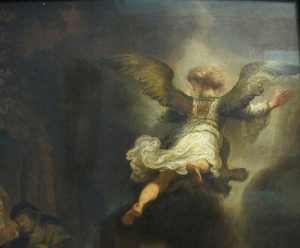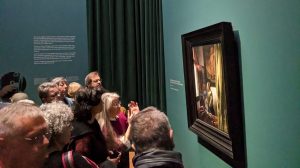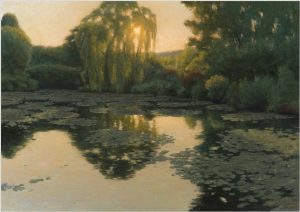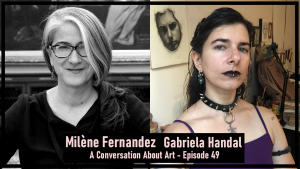As one of the 450-thousand visitors fortunate to have seen the historic, sold-out VERMEER exhibition at the Rijksmuseum in Amsterdam (February 10 to June 4, 2023), I felt compelled to share my experience with fellow Vermeer enthusiasts at the Salmagundi Art Club in New York.
Click below to watch the video (54 minutes, including the Q&A) and/or scroll down to read some highlights of the talk, which took place on May 19, 2023.
I would like to give special thanks to the art conservator and Salmagundi Library Committee Chair, Alex Katlan for inviting me to give this talk. I am also very grateful to the artist/oil painter Elena Galdkova, who was also a visitor at the VERMEER exhibition, for her support and technical knowledge. As a core-program student at Grand Central Atelier—a preeminent atelier, rooted in traditions pre-dating the 19th century—Elena shared insights I conveyed during my talk.
Why do we love Vermeer? He gives us space in between. Space to complete his paintings in our hearts and minds. He does it gently, quietly. The dialogue is so satisfying because he brings us into the present moment. There’s no past, no future, just you and what Vermeer loved to paint.
—Milène J. Fernández
Some key points:
- The exhibition is a collaboration between the Rijksmuseum in Amsterdam and the Maurithuis in The Hague, which took 7 years to organize.
- A main catalyst for the Rijksmueum to encompass 28 paintings—the most Vermeers to be exhibited together so far—was due to the generosity of The Frick Collection in lending all 3 of its Vermeers during the Frick Mansion’s renovations.
- Mysteries abound about Johannes Vermeer (1632–1675). He was initially called “The Sphinx of Delft” in connection to his contemporary, the painter Carel Fabritius (1622–1654).
- Vermeer’s first three years as a master painter was an intense period of history painting, including biblical and mythological stories.
- Vermeer’s first signature depiction of an interior scene occurs around 1656 to 1657, just a year after Delft was hit by the plague.
- Vermeer is revered as a master of light, composition, and perspective.
- The conservator, Dr. Jorgen Wadum has found pinholes in the vanishing points of 16 Vermeer paintings.
- Vermeer’s paint handling comprises wet on wet, thin glazes, impastos, and precise color mixing.
- Grisailles have been found in Vermeer’s initial layers of paint.
- No drawings have been found under Vermeer’s paint layers.
- Vermeer deliberately guides the viewers eye though the handling of soft and sharper edges.
- Dr. Jorgen Wadum believes Vermeer was probably influenced by Leonardo da Vinci’s writings on the perception of seeing and on sfumato, on creating soft transitions.
For a virtual tour of the Rijksmuseum exhibition watch Closer to Johannes Vermeer.





